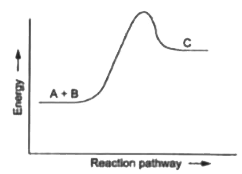For the equilibrium A+B⇔C+D, equilibrium constant may be equal to
[C].[A][D].[B]
[A].[B][C].[D]
[C].[D][A].[B]
all wrong
The correct Answer is:B
Step by step video, text & image solution for For the equilibrium A+B Leftrightarrow C+D, equilibrium constant may be equal to by Chemistry experts to help you in doubts & scoring excellent marks in Class 12 exams.
Updated on:21/07/2023Topper's Solved these Questions
Similar Questions
One mol each of A and B are heated in a 2-dm3 container. At equilibrium 0.5 mol of A was found to remain in the equilibrium mixture. Calculate the equilibrium constant for the reaction
A+B→2C+3D
View SolutionState whether the following statement is false or true. If the equilibrium constant for A2+B2⇔2AB is K, the equilibrium constant for AB⇔12A2+12B2 is 1/K.
View Solution
Knowledge Check
For the reaction 3A+B⇔2C+D, equilibrium concentrations of A, B and C are 0.03, 0.01 and 0.008 mol L−1 'respectively. What is the initial concentration of A?
A0.004B0.026C0.042D0.018For the system 3A+2B⇔C, the expression for equilibrium constant K is
A[3A]×[2B][C]B[A]3×[B][C]CC[A]3×[B]2DC[3A]×[2B]The compounds A and B are mixed in equimolar proportion to forin the products, A+B⇔C+D
At equilibrium, one-third of A and B are consumed. The equilibrium constant for the reaction isA0.5B4C2.5D0.25
1.1 mol of A is mixed with 2.2 mol of B and the mixture is kept in one litre flask till the equilibrium is reached. At equilibrium, 0.2 mol of C is formed. If the equilibrium reaction is
A+2B⇔2C+D
the value of equilibrium constant is
View Solution4 moles of A are mixed with 4 moles of B, when 2 moles of C and D are formed at equilibrium according to the reaction,
A+B⇔C+D
the value of equilibrium constant is
View SolutionAn equilibrium is A+B⇔C+D. Initially, we start with equal concentration of A and B. At equilibrium we find that the moles of C is two times of A. What is the equilibrium constant for the reaction?
View SolutionThe energy profile of the reaction: is shown as A+B⇔C is shown as,

The equilibrium constant for the said equilibrium
View SolutionA+B→C+D
Initially moles of A and B are equal. At equilibrium, moles of C are three times of A. The equilibrium constant of the reaction will be
View Solution
